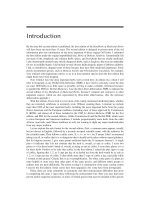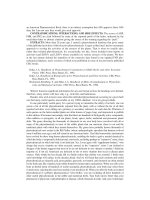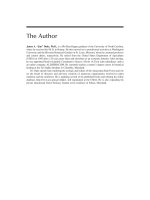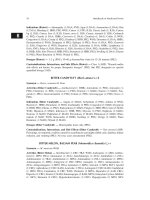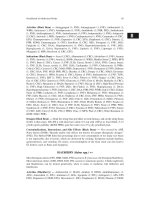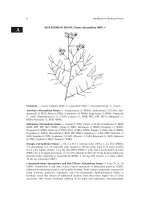Handbook of medicinal herbs phần 4
Bạn đang xem bản rút gọn của tài liệu. Xem và tải ngay bản đầy đủ của tài liệu tại đây (71.79 KB, 5 trang )
The Author
James A. “Jim” Duke, Ph.D., is a Phi Beta Kappa graduate of the University of North Carolina,
where he received his Ph.D. in Botany. He then moved on to postdoctoral activities at Washington
University and the Missouri Botanical Gardens in St. Louis, Missouri, where he assumed professor
and curator duties, respectively. He retired from the United States Department of Agriculture
(USDA) in 1995 after a 35-year career there and elsewhere as an economic botanist. After retiring,
he was appointed Senior Scientific Consultant to Nature’s Herbs (A Twin Labs subsidiary), and to
an online company, ALLHERB.COM. He currently teaches a master’s degree course in botanical
healing at the Tai Sophia Institute in Columbia, Maryland.
Dr. Duke spends time exploring the ecology and culture of the Amazonian Rain Forest and sits
on the board of directors and advisory councils of numerous organizations involved in plant
medicine and the rainforest. He is updating several of his published books and refining his online
database, still maintained at the USDA. He is also expanding his
private educational Green Farmacy Garden at his residence in Fulton, Maryland.
Abbreviations
Full reference citations are listed in the References section. Many of our primary reference citations
follow the consistent system (abbreviation, volume, page) format developed in my CRC Handbook
of Biological Activities. These are more meaningful to us, the compilers, than the PMID abstract
number (e.g., EB, or JE, or PR followed by a number then a colon then another number, always
means Economic Botany, Journal of Ethnopharmacology, or Journal of Phytotherapy Research,
respectively, followed by the volume number:page number).
The major references in this edition are indicated by concise and consistent three-letter abbreviations. The short explanation in the alphabetical sequence for the often-used three-letter abbreviations for our major references appear in the Reference Abbreviations section. Many primary
sources are often cited via the PMID index, which is indicated by an X, followed directly by the
PubMed serial number. Even for the $3000 worth of journals to which I subscribe, I can usually
find the PubMed citation in the same week that the journal gets my citation.
Conventional abbreviations appear here. Three types of citations, compactly squeezed into the
all important Activities and Indications paragraphs, are generously sprinkled elsewhere.
ABS abstract
ACAT Acyl-CoA: cholesterol acyltransferase
ACE angiotensin converting enzyme
AChE antiacetylcholinesterase
ADD attention deficit disorder
AFG in Afghanistan, as based on KAB
AHH arylhydrocarbon hydroxylase
AHP American Herbal Products Association
AIL Duke’s computerized AILS file, source
of The Green Pharmacy, etc.; soon
to be online
ALA alpha-linolenic acid
AMP adenosine monophosphate
APA American Pharmaceutical Association
APB as-purchased basis
ARC Aloe Research Council
ATP adenosine triphosphate
BAL Baluchistan, as based on KAB
BO body odor
BPC British Pharmacopoeia
BPH benign prostatic hypertrophy
cAMP cyclic adenosine monophosphate
cf compare with
CFS chronic fatigue syndrome
CHD coronary heart disease
chd child
ckn chicken
CNS central nervous system
COM commercial
COMT catechol-O-methyl-transferase
COPD chronic obsessive pulmonary
disorder
CORP corporation
COX cyclooxygenase
COX-I cyclooxygenase inhibitor
(sometimes COX-1 or COX-2)
COX-2-1 COX-2-inhibitor
CVI chronic venous insufficiency
DGL deglycyrrhizinated licorice
DHT dihydrotestosterone
DMBA 7,12-dimethylbenz[a]anthracene
(a carcinogen)
dml dermal
EBV Epstein-Barr virus
ED50 effective dose at which 50% of subjects are “cured,” “effected,”
“affected,” or “altered”
e.g. for example
EO essential oil
EPA eicosapentaenoic acid
EPO Evening Primrose oil
ERT estrogen replacement therapy
etc. et cetera
ext extract
f folklore, not yet substantiated
frg frog
g gram
GA glycyrrhetinic acid
GABA gamma-amino-butyric acid
GC Garcinia cambogia
GERD gastroesophageal reflux disease
GFG green farmacy garden
GI gastrointestinal
GLA gamma-linolenic acid
GMO genetically modified organism
gpg guinea pig
GTF glucosyl-transferase
h (as a score for an activity or indication)
homeopathic
HCA hydroxycitric acid
HCN hydrocyanic acid
HDR Herbal Desk Reference; online version under my Medical Botany Syllabus (MBS)
HFR human fatality reported
HLE human leukocyte elastase
HMG hydroxymethylglutarate
hmn human
HRT hormone replacement therapy
iar intraarterial
IBD inflammatory bowel disease
IBS irritable bowel syndrome
IC inhibitory concentration
ICMR Indian Council of Medical Research
ID50 inhibitory dose at which 50% of activity is inhibited
IgE immunoglobulin-E
igs intragastric
ihl inhalation
IL interleukin
ims intramuscular
inc incorporated
ind intradermal
inf infusion
ipr intraperitoneal
ith intrathecal
ivn intravenous
LD50 lethal dose at which 50% of experimental population is killed
LDlo lowest reported lethal dose
lf leaf
l liter
MAOI monoamine oxidase inhibitor
MDR multidrug resistant
mg milligram
MIC used differently by various sources;
minimum inhibiting concentration or
mean inhibiting concentration
mky monkey
ml milliliter
MLD used differently by various sources;
Merck meaning minimum lethal
dose; some other sources meaning
mean lethal dose, and some do not
define it (with apologies to the reader
from the compiler)
mM millimole
MMP-9 matrix metalloproteinase-9
mus mouse
NH3 ammonia
NIDDM noninsulin-dependent diabetes
mellitus
NKC natural killer cell
NO nitric oxide
NWP Northwest Province or Pushtu (dialect at border of northwestern
Afghanistan)
OCD obsessive compulsive disorder
ODC ornithine-decarboxylase
OPC oligomeric procyanidin
ORAC oxygen radical absorbance capacity
orl oral
OTC over the counter (or approved for sale
in Europe)
oz ounce
PA pyrrolizidine alkaloids
PAF platelet aggregating factor
par parenteral
pc personal communication
PEITC phenethylisothiocyanate
pers. comm. personal communication
PG prostaglandin
pgn pigeon
PKC protein kinase C
PMS premenstrual syndrome
pp pages
ppm parts per million
PSA prostate-specific antigen
PTK protein tyrosine kinase
rbt rabbit
RSV respiratory syncytial virus
RT reverse transcriptase
SAD seasonal affective disorder
SAM S-adenosylmethionine
scu subcutaneous
SF Stephen Foster
SGPT serum glutamic pyruvic transaminase
SL sesquiterpene lactones
SLE systemic lupus erythematosus
SN serial number (when followed by a
number)
SOD superoxide dismutase
SSRI selective serotonin reuptake inhibitor
sup suppository
TAM traditional Ayurvedic medicine
tbsp tablespoon
TCM traditional Chinese medicine
THC tetrahydrocannabinol
TNF tumor necrosis factor
tsp teaspoon
unk unknown
uns unspecified
UTI urinary tract infection
UV ultraviolet
VD venereal disease
VEGF vascular endothelial growth factor
VOD veno-occlusive disease
Vol volume
wmn woman
WPW Wolff-Parkinson-White (syndrome)
X solitary X in the title line of the herb
following the scientific name means
do not take it without advice from an
expert (think of it as a skull and
cross-bones)
X followed by serial number P M I D
(PubMed ID number)
XO external use only
ZMB zero moisture basis
µg microgram
µl microliter
µM micromole

